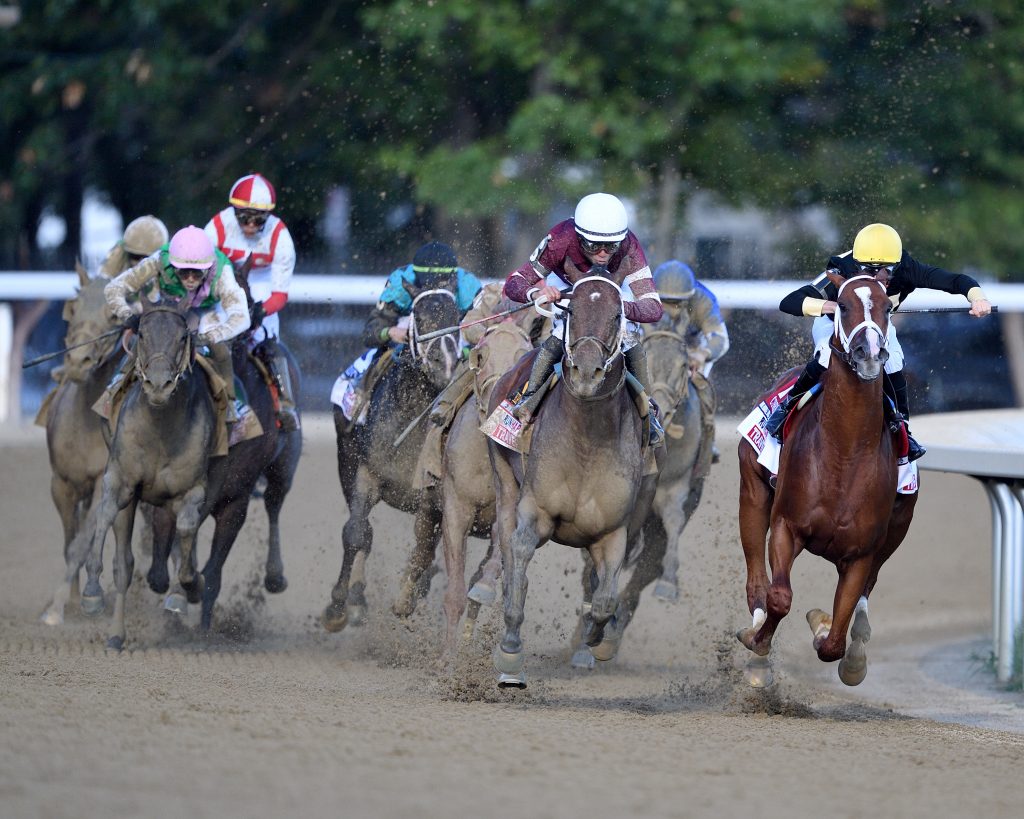
Epicenter on his way to winning the 2022 Travers (Dom Napolitano)
The National Thoroughbred Racing Association
August 21, 2023
1:00 PM
Operator: Ladies and gentlemen, thank you for joining the National Thoroughbred Racing Association National Media Teleconference in advance of the Travers Stakes.
I would now like to turn it over to Mr. Jim Gluckson, who will be leading the call. Please go ahead, sir.
Jim Gluckson: Thank you very much, Jenny, and good day, everyone and welcome to today’s NTRA National Media Teleconference previewing the 154 Travers Stakes presented by NYRA Bets, taking place this Saturday, August 26, from Saratoga Race Course in Saratoga Springs, New York.
Joining us today will be NTRA President and CEO, Tom Rooney; trainers Todd Pletcher for Forte and Tapit Trice; Jena Antonucci for Arcangelo; and representing Mage, assistant trainer, Gustavo Delgado Jr., and co-owner, Ramiro Restrepo.
A recording and a transcript of today’s conference call will be available later tomorrow on NTRA.com.
So, let’s begin our program today by welcoming NTRA President and CEO, Tom Rooney.
Tom Rooney: Thanks, Jim. Thanks for everybody for joining the call, today. I want to say on a personal level, I’ve gotten to meet the participants in some capacity or another, over the last several years. And I will say that all of them are first-class and people that I think improve our sport and it certainly helps me along the way and it’s just been an honor to get to know them and meet them.
I haven’t met Gustavo but if Ramiro vouches for him, then he’s okay by me. But Jena and Todd and Ramiro have been very, very gracious with their time with me and are great people.
So, this year’s Travers Stakes is living up to its billing as the next Midsummer Derby with an incredible field. Due to the prestige, this race attracts some of the toughest competitors in our sport, all striving to make their case for the highly coveted trophy awarded to the best three-year-olds at our Eclipse Award in Palm beach in January.
For the fifth time in its 154-year history, Saturday’s Travers will feature all of the winners of all three Triple Crown races. Pretty incredible.
This race is packed with competition such as Derby champion Mage, seeking a return to the winner’s circle; Belmont Stakes winner Arcangelo, who I got to meet, aiming for his impressive fourth consecutive victory; and last year’s two-year-old Eclipse Award winner, Forte, looking to repeat as the three-year-old champion.
I did some checking and found out that there’s only been two other horses that have won two-year-old Eclipse Awards and three-year-olds in the last 20 years. So, that’s pretty rare air up there for Forte trying to make the case for that.
The lineup offers that and a lot of other exciting story lines that will encapsulate the essence of racing.
So, with that, I’d like to wish all the Travers connections the very best luck, as we move one step closer to the Breeders’ Cup World Championship, this fall in Santa Anita.
With that, I’ll turn it back over to Jim.
Jim Gluckson: Thank you very much, Tom. All right, why don’t we begin now with our first guest, Todd Pletcher. Todd will be entering Repole Stables and St. Elias Stables Forte, and Whisper Hill Farm and Gainesway Stables, Tapit Trice, for the Travers, later tomorrow evening.
Todd has won the Travers twice in his career and Todd, thank you very much for joining us, today.
Todd, how are you doing? Jim Gluckson here. How are you?
Todd Pletcher: Great, thank you.
Jim Gluckson: All right, Todd, you were very pleased with the workouts of both your horses for the Travers on coming into Saturday and including the addition of blinkers for the horses.
I want you to comment on that first, if you could, on each horse. But let’s start first with Forte, since his victory in the Jim Dandy.
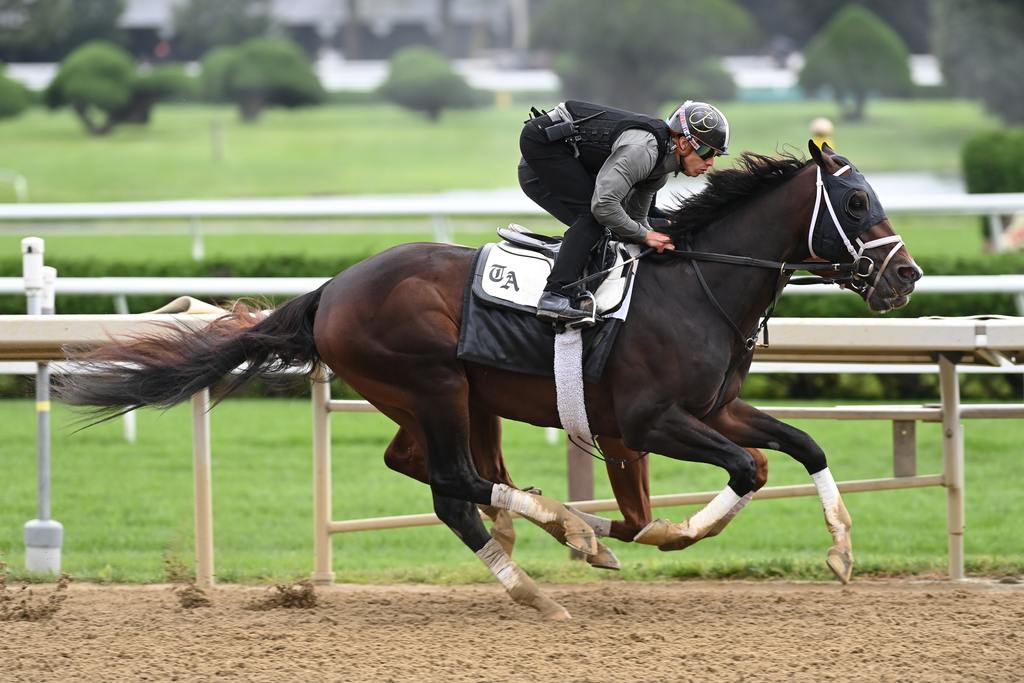
Todd Pletcher: We’ve done very well since then. We worked him twice, once without blinkers and last Saturday, with blinkers.
I read and I had spoken about it quite a bit. We felt like in the Florida Derby that he lost a little bit of focus in the far turn and was able to recover from that and get up for the win.
But we also felt like he did a little bit the same thing in the Belmont, kind of lost focus a little bit in the far turn and then came on closing willingly, after that.
But we’re sort of seeing some of the same things from him in his breezes where you see such a talented horse, everything comes so easily to him, that I think he sometimes just gets a little bit distracted.
So, we trained him a little bit in the blinkers before the Jim Dandy, and we felt like we got the desired effect of a little more focus without making him to headstrong. And so, that’s why we decided to do so, to put them on for the Jim Dandy.
And after being able to win that, we’re going to leave them on for the time being, anyway.
Jim Gluckson: All right, just shift over now to Tapit Trice. I think you mentioned, of course, that he benefits from a strong pace up front.
Do you plan to keep him closer to the pace this time, as opposed to previous races? What is the strategy in that respect, as far as how the race might set up?
Todd Pletcher: Well, we really, he doesn’t have much control over how the pace of the race is going to unfold. It looks like Scotland is primary speed to the race and who we’re expecting to enter. And we’re going to put blinkers on Tapit Trice with the hope that it’s going to focus him in a little more, hopefully, allow him to get into the race a little sooner.
He’s historically been a horse that reacts okay to the doors opening but just doesn’t have a lot of gate speed. So, he’s kind of found himself in a compromised position, several times.
And we’re hoping that the blinkers can just sharpen him up enough to maybe have him laying a bit closer while certainly we wouldn’t expect him to be a horse that would be on or near the lead.
Jim Gluckson: All right, very good. Well now, let’s open it up to some questions from the media that are on the line and see what they have to say.
So, Jenny, let’s go to that portion of our program, please.
Operator: Thank you. Ladies and gentlemen, should you have a question, please press the “*”, followed by the “1” on your touchtone phone. You will hear a three-tone prompt acknowledging your request. Questions will be taken in the order received.
Should you wish to cancel your request, please press the “*”, followed by the “2”. If you’re using a speaker phone, please lift the handset, before pressing any keys.
Once again, that is “*”, “1” should you wish to ask a question.
Your first question is from John Stettin from Past the Wire. Please ask your question.
John Stettin: Hey, Todd, how are you?
Todd Pletcher: Good, thank you.
John Stettin: Is there any concern when you’re going into a race as significant and as important as the Travers when you’re going in making a blinker change and a rider change at the same time?
Todd Pletcher: I think there’s always concerns, anytime you’re making any changes. But I think we’ve seen enough in the training that we like the way he’s adapting to the blinkers.
José Ortiz breezed him on Saturday, got familiar with him a little bit better. I think he’d actually breezed him a time or two this winter, as well.
So, sometimes, when a horse is not performing the last couple of races, that would probably be a little bit critical because he did run a good race in the Belmont. But I think it might be good for him, a change of equipment and a new rider.
And sometimes, when you’re not having the success, you expect from a horse that shows as much talent as Tapit Trice has, then maybe making some changes could produce the desired effect.
John Stettin: Thank you, Todd, and good luck with both horses on Saturday.
Todd Pletcher: Thank you.
Operator: Thank you. Your next question is from Mr. Ron Flatter from Horse Racing Nation. Please ask your question.
Ron Flatter: Hi, Todd. The spacing of the Triple Crown races has certainly come up again, what with the Stronach Group making the noise it’s making about the Preakness.
But moreover, could you talk about just the thought in terms of placing horses in races as three-year-olds nowadays and the fact that the Travers seems to be spaced so perfectly that it lined up so well for the three Triple Crown winners, plus Forte?
Todd Pletcher: Yeah, I mean, it’s positioned where it’s always been, and I think after you complete the Triple Crown races, whichever ones you decide to run in, then most of the top colts are going to begin to focus on the Travers and how they’re going to get there and whether or not they’re going to have a prep in between and if that prep is going to be in the Haskell or the Jim Dandy or what have you.
So, I think it’s a pretty straightforward target, really. And it’s positioned well so that the horses that have been through the Triple Crown campaign have the opportunity to freshen up a little bit and come into it in peak form, hopefully.
Ron Flatter: What are your thoughts about the spacing of the Triple Crown is being bandied about now?
Todd Pletcher: Such a complex question. It’s so many layers to it and factors and certainly, the Derby is where the Derby is, and that’s where it will always be. And so, you’re going to have to have two different tracks and corporations agree on where they would space the other two and how that would work out.
So, part of me, the traditionalist, likes the way it is because it’s so difficult to accomplish. And the other side of it is I think we see a lot of horses not running in all three legs, and you can make an argument that it would be better for racing if all the top colts participated in all three races.
So, there’s a lot to dissect there.
Ron Flatter: Good luck, Todd. Thank you.
Todd Pletcher: Thanks, Ron.
Operator: Do you have a question, sir? Please continue.
Jim Gluckson: Let’s just see if there’s anybody else that may want to come in while we’re waiting.
Todd, I just want to ask a question to you, just changing subjects here about Nest and her heading towards the Personal Ensign.
Todd Pletcher: Yeah, she’s doing fantastic. She’s an amazing filly. I was concerned running in the Shuvee off of pretty length way off since the Breeders’ Cup Distaff and running a mile and an eighth against top class mare like Clairiere and similar to the ways that Nest rebounded out of the Belmont Stakes, last year, she seems to thrive on activity.
And a race that I was concerned about that might kind of take some energy out of her, knock her out a little bit, she’s just really excelled since the Shuvee, and we’re excited to get her back in the Personal Ensign and really pleased with the way she’s coming into it.
Jim Gluckson: Very good–very good. Thanks. Thank you, Todd.
No further questions that have come in. So, Todd, I want to thank you very much for taking the time today to join us on the call. And best of luck to you, this weekend.
Todd Pletcher: Thanks very much, Jim, appreciate it.
Jim Gluckson: You got it. Todd Pletcher, everyone. Let’s now shift to our next guest, please. That would be Jena Antonucci. Jena will be entering Blue Rose Farms Belmont Stakes winner, Arcangelo, on Saturday.
And Jena, of course, had the final work for Arcangelo last weekend, breezing five furlongs, excuse me, last Wednesday.
Jena, Jim Gluckson here. Welcome to the call.
Jena Antonucci: Hi, Jim. Thank you very much.
Jim Gluckson: Great, I wanted you to comment on that breeze last weekend with, I think, the previous weekend, August 6, you had a more demanding work at the time. But just talk about the preparations and how they’ve gone there in the last weeks.
Jena Antonucci: Our focus this last work was a, we’ll call it a cleanup work as Joey had everything accomplished that we were looking for in the work, prior.
So, like you stated, it was kind of a heavy lift, the work prior, as we wanted to kind of check all the boxes we were looking to see checked. And just that last work was more of a sprinkles on top, shall we say.
Jim Gluckson: All right. Well, obviously, there’s been a lot of talk about the preparations themselves, the decision to be made after winning the Belmont Stakes, not to race here until the 11 weeks in between.
What went into deciding that that’s the best course of action for the horse?
Jena Antonucci: This horse had had most of his career spaced out with a lot of time. We just found has given him that breathing room he needed to continue to mature and grow up and fill in and fill out.
And it really wasn’t a heavy debate, to be honest, the tightest races he had run back-to-back was the Peter Pan and Belmont. And so, continuing to that have come out of the big effort, the Belmont, and put himself where he needed to for this race was kind of an easy conversation.
Jim Gluckson: All right. Well, just one other question I wanted to ask and maybe ask this to each of our guests today is how the race, obviously, without knowing post positions, how it shapes up for him or going some of the competition as far as you see the type of positioning or, tactically speaking, what can you comment on at this time?
Jena Antonucci: We’re super excited for the race. I think the quality of the field is going to be a lot of fun and great for racing fans. And we’re so blessed to have such a versatile colt that we can really back into any kind of scenario, which is such a blessing to have that we’re not tied to having to have one set up to be able to find success.
So, super excited for a great day of racing for the industry, for the fans. And let’s go win a race.
Jim Gluckson: All right. Well, Jena, let’s see if we have any questions from the media on the line. So, Jenny, let’s turn it over to you and see what we have.
Operator: Yes, thank you, ladies and gentlemen. Once again, that is “*”, “1”, should you wish to ask a question.
Your first question is from Ron Flatter from Horse Racing Nation. Please ask your question.
Ron Flatter: Hi, Jena. How do you regard the fact that being at a mile and a quarter, your horses one at a longer distance, which is certainly a feather in his cap?
Do you consider that an advantage or are there other distance questions that come in, in the cut back?
Jena Antonucci: Hi, Ron, thanks for that. As you know, we won at a mile. We won at a mile and an eighth, and we one at a mile and a half. So, again, just so blessed to have a colt that is so versatile and has just what I would call some DNA speed in there from his dad where it just makes it so dynamic in that regard.
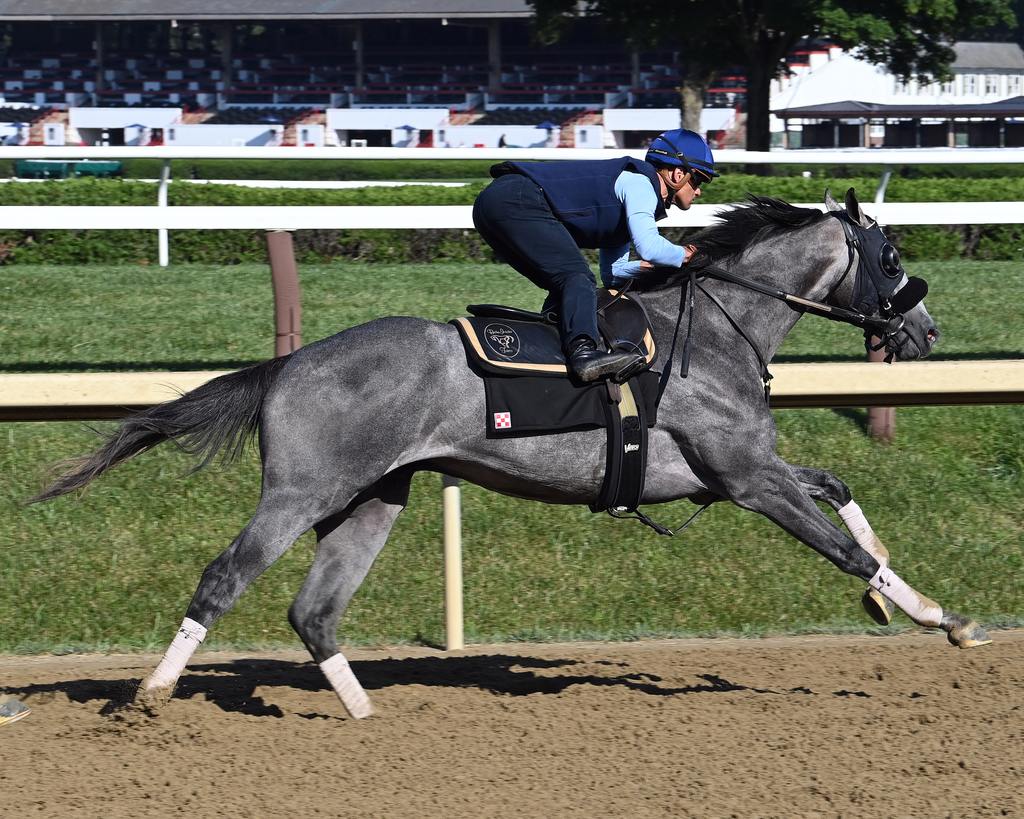
So, it’s not often you can say you have to cut back to the mile and a quarter and what does that look like. So, excited to see it and just excited for him to have the opportunity against this kind of group.
Ron Flatter: How do you want the pace of the race to unfold if it were ideal? And I presume it will be Scotland that’s going to dictate it.
Jena Antonucci: Again, being so lucky to have this versatility, definitely not tied onto one business plan in that race. I would expect that National Treasure isn’t going to doddle, as well. So, I would be surprised if there wasn’t an honest pace in the frontend.
And we’ve been able to sit close to a slower pace and set off of a little quicker pace, and we’re going to let Javier do what Javier does and ride a smart race.
Ron Flatter: And finally, how big a deal was it that you guys were able to get Javier before there was, I guess in essence, before the folks at Mage could get him?
Jena Antonucci: Yeah, I guess living in it didn’t feel that way. I’m a big believer that things just work out and you’ve just got to stay in your space and do what you do. And the nice part is this colt has gotten so professional in his job that whoever ended up on him was going to know what to do and how they needed to do it.
So, thrilled that we do have him. Obviously, I’m thankful for that. And they’ve had a lot of success together. And so, hopefully, we can add some more to that.
Ron Flatter: Good luck, Jena. Thank you.
Jena Antonucci: Thanks, I appreciate it.
Operator: Once again, that is “*”, “1”, should you wish to ask a question.
Your next one is from Paul Halloran from the Saratoga Special. Please ask your question.
Paul Halloran: Hey, Jena. I’m wondering, your outlook. Obviously, a bit of a long shot going into the Belmont, coming off the Peter Pan win. And that was you’ve gotten a lot of well-deserved attention, since then.
But now, you’re going to this race as one of really, the main players. Has your outlook changed at all heading into this race versus the Belmont?
Jena Antonucci: Thank you for that. No, that stuff kind of becomes white noise in the big picture what we do and just staying focused on the colt, making sure we’re checking all the boxes and that he’s in his optimal space to run.
So, that stuff, fortunately, doesn’t move the needle and how we prepare and how he’s ready to run. And it’s fun for the industry to be able to talk about it and it’s important for the industry to enjoy that and talk about it.
And I’ll let them do that, and I’ll stay focused on him.
Paul Halloran: Great. Thank you.
Operator: Thank you. Your next question is from John Stettin from Past the Wire. Please ask your question.
John Stettin: Hey, Jena. You had said that after the Belmont, the plan was to go directly to the Travers, and that was a relatively easy decision.
Has Arcangelo shown you in that time, everything that you would like to see as far as development, progression, maturing, everything that you were looking for and hoping for so that you’re confident, regardless of what happens Saturday that that was the right call?
Jena Antonucci: Hey, John, yeah, definitely super pleased with how he has responded to the time to standing and more maturity, strength. His physicals just continue to come more. And so, I don’t have any doubt with where we are with our decision, how he’s progressed through each work.
Javier has been extremely pleased with his feedback on every breeze and has kind of been the plan of what we were looking for and how we ramped up each work.
Robert, who obviously rides him every day, is just very pleased with how the horse is coming into himself. And I can usually gauge where we are by how hard Robert is blowing when he gets him pulled off after training, each day.
John Stettin: Thank you, Jena. All the best on Saturday.
Jena Antonucci: Thank you, I appreciate it.
Jim Gluckson: Are there any further questions at this time?
All right, well, seeing no further questions for Jena, I wanted to thank Jena for your time today for this call on the Travers Stakes and wish you the best of luck to you and your team, this coming Saturday.
Jena Antonucci: Thank you, we appreciate it.
John Stettin: Bye-bye now.
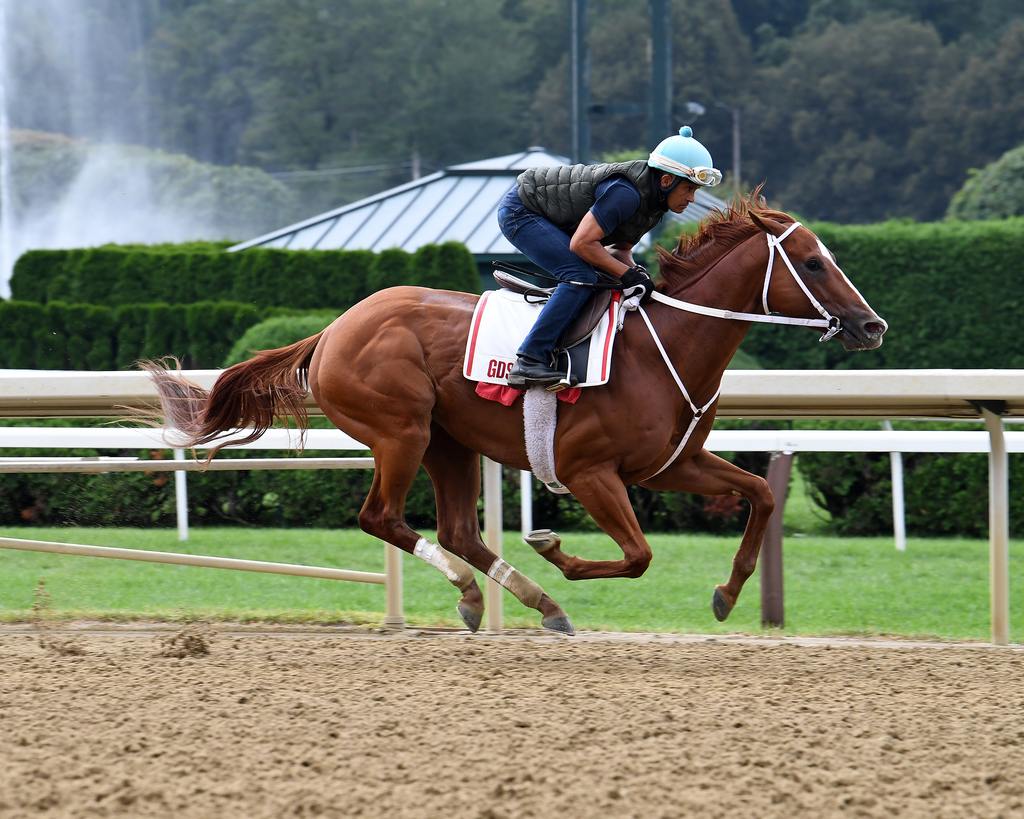
Jim Gluckson: Thanks, everyone, Jena Antonucci. Now, let’s move on here to our third guest. I’m going to have the team representing Mage; assistant trainer, Gustavo Delgado, Jr. and co-owner, Ramiro Restrepo. And let’s bring them into the call.
Hi, Ramiro.
Ramiro Restrepo: Yes, I’m on.
Jim Gluckson: And we’re going to wait for Gustavo to join.
Gustavo Delgado, Jr.: I’m here, Jim, I’m here. How are you?
Jim Gluckson: Great, great, thank you, both of you, for joining us, today. Great to hear from you both. Excited for everyone here for the Derby winner to be in the Travers.
Gentlemen, over the weekend, Mage breezed six furlongs at 1:12.98. You were both very pleased with this work. You arrived earlier in Saratoga than you did for the Derby in the Preakness.
Can you comment on the adjustment of arriving earlier and the advantages of doing that than in the previous two Triple Crown races?
Gustavo Delgado, Jr.: I will take that one. Well, that’s one thing that we wanted to do, my dad [Gustavo Delgado, Sr.] wanted to do, to come here early and just give the horse enough chance to trim the ties and not just add also get a feeling on the track several times, get a couple of breezes. And that seems to being thing.
Right now, we think that the horse, it’s about to give us a good effort this Saturday, and we’re very content and happy all things have turned around. And so far, so good, I will say.
Jim Gluckson: All right. And just following up here. I’ve been asking the other guests today about, tactically speaking, how the race shapes up. You would like a lot of pace up front but Ramiro, if you can comment on that, please, about tactics, we’d like to hear a little bit about that.
Ramiro Restrepo: Well, I won’t be riding him. Unfortunately, I won’t–we ought to make weight this week. So, Louie [Saez] is up. And luckily, he’s the leading rider and future Hall of Famer.
He’s been on the horse before and you really have to give the keys to the Ferrari that Louie, at this point, he’s familiar with the horse and let him dictate.
The horse is quite versatile. He won wire to wire. He’s stopped before in the half goal and in the final debut. And he’s come from up the pace. So, he’s a very handy horse. He just needs to be placed, get a good break, all the usual thoughts, just get a good break, find somewhere, a good positioning. I’m sure it’s pretty ideal to be–I believe the field looking like eight or nine horses, at the moment, or seven, possibly.
And just to be somewhere in the middle to top half of that field and create some home. See what we’ve got under the engine.
Jim Gluckson: All right. Well, gentlemen, let’s see if we have some questions from the media on the line. So, Jenny, let’s take us to the next section of the call, please.
Operator: Thank you. Once again, ladies and gentlemen, that is “*”, “1”, should you wish to ask a question.
Your question is from Ryan Martin from New York Racing Association. Please ask your question.
Ryan Martin: Hey, Ramiro, this question is for you. Seems like you’ve been on double duty, daily. I see you were in France at the Arqana sale. Just kind of talk about throwing that into the mix of getting your sort of horse for the lifetime ready for the Travers.
It seems that you kind of — sort of like I said, double duty in a lot of different places at once.
Ramiro Restrepo: Ryan, it takes a village to have success in this industry. That’s why partnerships and alliances are the most important thing. I can’t think of anyone better else than Gustavo Delgado, Senior and Junior, to handle everything.
I’m not riding the horse; I’m not training the horse. I’m not feeding the horse. At this point, I’m a blessed passenger. And it’s just–nothing could make me feel more at ease than to have Gustavo, not only as my partner but also as, both Gustavos as my partner and also the trainers.
So, handle it. They’re made for this, and this is what they’re built for. They’re experienced. Their resume speaks for itself. And it makes my job as a bloodstock agent to be able to go ahead and participate in other aspects of the industry, even during these times where we’re coming up on such an incredible upcoming race, to focus on my other endeavors.
I was at Arqana all week and was able to purchase a really beautiful unique filly and just keep the program going forward.
Before that, I was at the Saratoga sale. We got a really nice Omaha Beach colt that’s going to be going to Gustavo’s barn at the beginning of the year when he turns two.
And you know just have to–everybody does–it’s one team, one dream. We’re all here to–working together to achieve everything we wanted to do in this business. And that’s why everybody is doing what they need to do to put their best foot forward. So, Gustavo and father and son are on the home front handling everything as they should, and they’re doing a great job, clearly.
And I’m mining for future goals and just keeping that aspect of our dream going.
Ryan Martin: And kind of talk about the partnership, yourself, Commonwealth [CMNWLTH], the other two owners, as well. Just kind of talk about what’s the experience with them and your having those partners on board has been like.
Ramiro Restrepo: It’s been great. Junior and I have been going out together and working the sales and buying horses for several years now. And obviously, with the OGMA investments, a group that he leads have been wonderful supporters of myself to give me the support, not only at the sales financially, but also in his expertise and helping iron out our final picks.
Commonwealth and Sam Herzberg, it’s the only horses that we own together, which is Mage.
But they’ve been fantastic. It’s been a dream come true for Sam of Sterling Racing to fulfill his derby that he was chasing for such a long time. And Brian and Chase Chamberlin of Commonwealth, bright young guys, they’ve had a successful service early on with Country Grammer and We the People.
And it just goes to show, they’ve put themselves in some great partnerships and have had some success in their short time. So, it’s been a seamless journey with them. We’re all really enjoying this ride.
It obviously helps when you have a horse of this caliber that falls into your life. And if this was the Olympics and we’re sitting here with medals, to have a Kentucky Derby gold metal, a half gold silver, a Florida Derby silver, a Preakness bronze.
I mean, those are only things that you could dream of if you were an Olympian. So here we are, this horse giving us all metals and all amazing rides of our life.
So, it’s been a harmonious, beautiful moment. And we just want to continue this ride as far as it can take us.
Ryan Martin: And Mage was one that was highly regarded. Even going into the Fountain of Youth, I remember hearing a lot of buzz on. And so, it seemed like he was one that, I guess the secret was sort of out on him, early on.
Why don’t you talk about how he’s developed then versus now.
Ramiro Restrepo: I think people look at PPs and sometimes don’t look beyond how a horse really matures from the two-year-old sale on to the three-year-old sale.
He’s gone from a boy to a man from race to race. Gustavo’s gone to plenty of how the Florida Derby really turned on a light bulb on the horse. Every race, he just becomes so much more professional.
And now more than ever, he’s just a consumate pro. And the way he takes to his training and just marches on, he’s in full game mode and so really matured. And that experience, everything came at him, rather quickly.
He’s one of three horses to ever win the Kentucky Derby without running a three. And we gave him no time off. He’s run in four consecutive Grade 1s. This will be his fifth consecutive Grade 1. I don’t think any other three-year-old can speak to that on their resume.
And it just shows the constitution of the horse, the training skills of Gustavo senior and junior and the constitution and heart that this horse has. He’s got tons of talent, tons of heart, tons of mobility, and it’s been developed in fantastic fashion.
And we just hope that that continues, that consistency and that effort. It’s just been marvelous to sit back and watch.
Ryan Martin: Yeah, I know, it definitely has. Thank you so much for your time, Ramiro. Best of luck.
Ramiro Restrepo: Thank you.
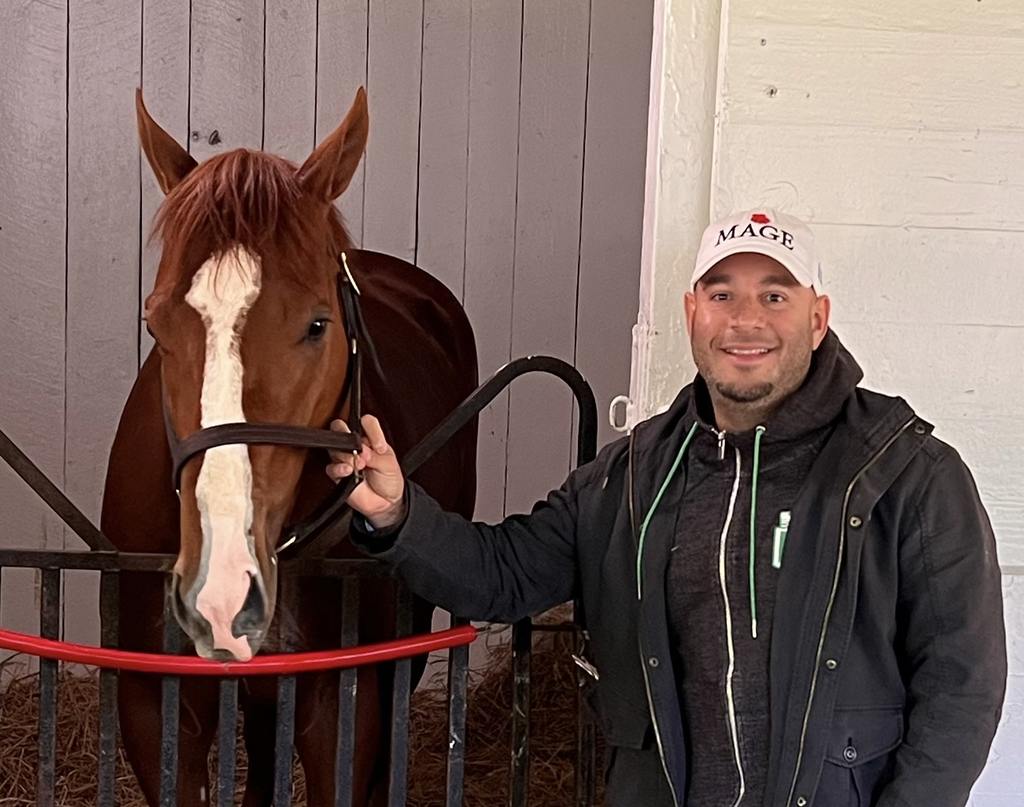
Operator: Thank you. Once again, that is “*”, “1”, should you wish to ask a question. Your next question is from Robert Kieckhefer from United Press International. Please ask your question.
Robert Kieckhefer: Hi, thanks for joining us, appreciate it. You kind of touched on what I was going to ask about–Mage has been a really busy boy, this year.
What’s the thinking that goes into their planning for spacing these races? And given how much he’s raced this year, what could we look forward to, going forward for the rest of the year?
Ramiro Restrepo: Gustavo.
Gustavo Delgado Jr.: Well, I think it’s important to highlight the fact that we want, that we had the Kentucky Derby as the main goal.
We’re kind of rushing him a little bit. Just to say that at second start, he faced forcing with a two-year-old champion. And that’s what we needed to back then because it was–we need to get the points in order to participate in the Kentucky Derby.
So, that’s one thing that–we have chosen a route like going and being more conservative, I will say. We might have a horse that could be maybe undefeated. But definitely, we have to play each race with a short term between and the spaces we generated were so short and the difficulty of each one was very high.
So, and he still delivered in the race that we were pointing him for. So, I will say that’s a major accomplishment.
And then after that, we just decided to take the Travers as the main goal, take only main goal after the Kentucky Derby. And that’s exciting what we’re doing with him and definitely after the Preakness, that’s what we’re thinking about and here we are in Saratoga.
And he seems to be ready for a big race. So, in that regard, we’re pretty content and we’re excited about what’s going on Saturday because before everything, I think we’re all racing fans, and this is going to be an exciting race.
It will determine who is the best three-year-old. That’s my opinion. And I think we still have a good shot, and that’s what we want to see.
I’m really excited about that. And not just me, I think everybody, I mean, it’s been a while. But we don’t have a Travers like this competitive. And to be honest, you can make a case for each horse in the race, I will say.
So, I’m personally excited and looking forward to it.
Robert Kieckhefer: I’m excited about it, too. Could we expect a little break after this for the colt?
Gustavo Delgado Jr.: Well, we want to go one race ahead of time, though. But in a perfect world and the best scenario, we might be thinking about the risk of busting it, risk of class, you know. It’s, again, one race at a time and the main thing is the way that a horse comes back to finish the race and then take it in.
Robert Kieckhefer: Go get’em.
Gustavo Delgado Jr.: Thank you, appreciate it.
Operator: Thank you. Your next question is from John Stettin from Past the Wire. Please ask your question.
John Stettin: Hey, guys. Either one of you could take this. And you both kind of alluded little bit to it in some of your previous answers.
But when Mage raced Forte back at Gulfstream Park, Mage was relatively inexperienced, and Forte was considerably more seasoned. Yet, you guys ran a very good second with a lightly raced horse to a more experienced horse.
We know that you didn’t get to face him again in the Derby but now you’re going to get to face him months later in the Travers.
So, what I would like to know is how much better of a colt is Mage today with the experience that he’s had and alluded to the amount of great warms that he’s running. How much better of a colt is he today than he was when Forte last saw him in the stretch at Gulfstream Park?
And assuming, unlike last year where Flightline was a very heavy favorite to win the classic, this year looks much more likely that a three-year-old can win the classic. But assuming that doesn’t happen, and the three-year-old doesn’t win the classic, is a Travers winner, in your opinion, the clear-cut three-year-old champion?
Ramiro Restrepo: Sure, I mean, look, any analyst or horse player that reads the Racing Form and other chart lines can see. Forte coming in to the Fountain of Youth was the two-year-old defending champion, I believe he had three Grade 1 winners or four Grade 1 wins at the time and was the Breeders’ Cup champ.
And he was taking on a horse that was coming off a maiden win and was eligible for 1X.
So, I mean, night and day, and here we are fast forward, he’s running in multiple Grade 1s, multiple American classics, won the Kentucky Derby. Physically, he’s grown, he’s filled out and has got the proper seasoning to take on not just Forte but six, seven other highly accomplished and talented horses.
We’re not here focusing in on one particular horse. We’re focusing other than our horse. It’s been about developing Mage, making sure he’s happy, sound and fit and bringing him along as the best stewardship that we can.
And like Gustavo said earlier in his previous answer, once the Kentucky Derby dream was accomplished, our next goal from the moment he crossed the Preakness wire was the Travers. And everything has been pointed towards building Mage up in a perfect ideal world to give his best possible effort in this race.
He’s got several races under his belt now and has run in all distances. And he’s been in Florida, New Jersey, Baltimore, Saratoga, Kentucky. He’s been on the road more than Mick Jagger and the Rolling Stones.
So, at this point, you can’t ask anymore from the horse, himself, to be prepared for these kind of bright lights. We have intended to prepare him for this moment, and we’re very pleased with the way he’s come along. And it’s a fantastic field, something that horse fans, horse players, YouTubers, analysts, expertise, the media can all rally around.
This is why we love this sport. When the stars come together and it feels like seven or eight of them are going to be lining up on Saturday, and we’re just blessed to be one of those and hope we can come out on top.
John Stettin: Do you think that people forget a little bit about how tactical and actually assess Mage can be early. He did when his debut. Was that seven furlongs, I think, or six or seven furlongs? He was on the pace the entire way.
Ramiro Restrepo: Yeah, he wired them, wire to wire. You know, it’s been circumstance. He was quite immature coming out of the gate in his second and third lifetime starts.
In the second lifetime start, since we didn’t know, what can you really know about your horse’s running style in his second race? We just kind of went along with the, well, go towards the lead. And his break caused him to go wide on the first turn and chase the pace to try to get the lead.
And yet, overcoming so many things in the race, he still ran on a strong fourth. When he didn’t break in the Florida Derby, Gustavo had informed Louie that he had worked the horse during the week in the weeks between the Fountain of Youth and the Florida Derby to be able to sit a third and relax.
So, it was a circumstance when he broke slow in the Florida Derby to let him sit where he was, which was last and then make that big sweeping move.
In the Kentucky Derby, Gustavo Sr. spoke to the rider before the race and had both scenarios. If you break, fantastic, great, put yourself in a forward spot and let him go. And when he didn’t, then he just sat what he did and made the big move. Yet, in the Haskell, he broke well and was able to sit relatively close to that and make a good strong move.
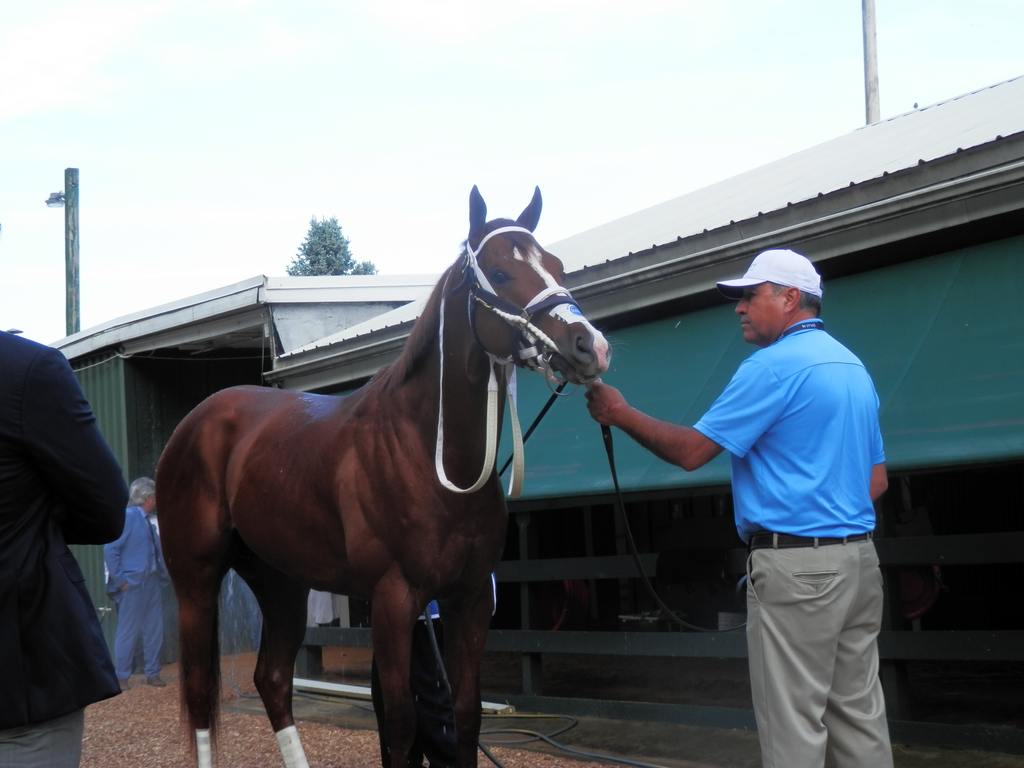
So, look, you have to look at it both ways. I get it, there’s experts and media and fans who want to discuss race strategy and odds and what the public might think or opine about the horse. And that’s great because it makes for conversation and exchanges and topics to discuss.
And that’s great. But for us, all we could do is just focus on our colt, on his health, on his soundness, on his happiness, on his business and then leave it between Gustavo Senior, Junior, and Louie to make the strategy in-house and put the horse in the best possible to win the race, and go from there.
Jim Gluckson: Let’s move on to our next questioner, please.
John Stettin: All right, go ahead.
Operator: Your next question is from Ron Flatter from Horse Racing Nation. Please ask your question. Mr. Ron Flatter.
Jim Gluckson: Did we lose Ron? Let’s give Ron a second, see if he maybe lost the line for second and see if there’s any other questions.
Okay, well, it doesn’t appear that we have Ron still on the line. So, that being the case, I think that is the conclusion of our questions.
And I really want to thank both Gustavo and Ramiro for joining us today to talk about Mage and wish you both the best of luck on Saturday.
Gustavo Delgado Jr: You’re very welcome, Jim, I appreciate that.
Ramiro Restrepo: Thank you, Jim.
Jim Gluckson: All right, well, everyone, that will conclude our call for today. Thank you so much for joining us for all of our guest today.
I want to remind you that there will be a transcript and an audio recording of the call produced some time tomorrow afternoon, and you can look for that on NTRA.com.
Thanks very much for joining us, today.
Operator: Thank you. Ladies and gentlemen, the conference has not ended. Thank you all for joining. You may all disconnect.



